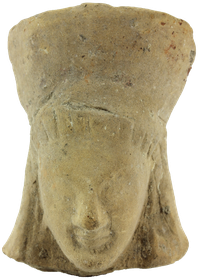Small female head with polos
Description: A high polos which widens moderately towards the top adorns the small head. The elongated oval face rounds in the area of the cheeks and gradually tapers towards the protruding chin. In the side view, one recognises the receding profile. Horizontal strands emerge from under the polos, framing the high forehead in a shallow arch. Long hair falls densely bundled in thin strands. On the left side of the head the ear can be seen, stylised as a bow-shaped elongated structure set off from the shoulder hair[1]. The full, closed lips are barely raised at the angles. They are set off from the chin and smooth cheeks by semi-circular folds. High orbits of little depth lie above the slightly protruding eyeballs, which are arched above and horizontal below.
Commentary: In contrast to the rather highly rectangular silhouettes of Locrian head protomes, Inv.-No. T I-10 shows a contour line whose tapering begins gradually at eye level and increases markedly in the lower cheek section. In this respect the head resembles specimens from sanctuaries in Paestum/Poseidonia[2], with which it agrees in the formation of the eyes and the shape of the polos. The facial shape of individual heads at San Biagio/Metapont[3] is similar. A head from the Demeter sanctuary at Herakleia also shows the elongated form of the T I-10 example, but differs from it in the protruding polos, the plastically indicated eyelids and brows, and six shortened central strands above the forehead.
Stylistically and iconographically, T I-10 resembles above all specimens from Paestum[4]. In contrast to the darker reddish-brown of the statuettes from Poseidonia, the example in Giessen is somewhat lighter in colour.
Determination: Thrid quarter of the 6th century BC, from Lucania (Paestum?)
[1] Similar stylisations with local heads, Barra Bagnasco 1986, 81-83 nos. 126. 129 pl. 23.
[2] R. Miller Ammerman, The Naked Standing Goddess: A Group of Archaic Terracotta Figurines from Paestum, AJA 1991, 203-209 figs. 1, 3, 6; from Taranto ibid. 214 fig. 14; A. Dell’Aglio – A. Zingariello (ed.), MARTA. Il Museo Nazionale Archeologico di Taranto (Tarent 2009), 38.
[3] Olbrich 1979, 207 no. C 22 pl. 51; 288 no. C 189 pl. 85; R. Miller Ammerman uses matrix-like statuettes from the sanctuaries of Poseidonia and Metapont to demonstrate the close relationship between the workshops, id. 1991, 212 f. figs. 11 and 12.
[4] Cf. the contours of the faces, the shape and position of the eyes, the prominent chin and the mouth area enlivened by ring-shaped wrinkles, R. Miller Ammerman ebenda 1991, 209 figs. 5. 6.




